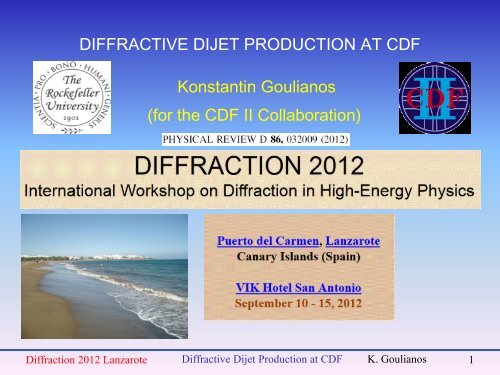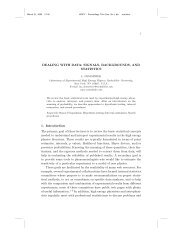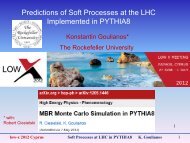DIFFRACTION 2012, Lanzarote, Canary Islands, Spain
DIFFRACTION 2012, Lanzarote, Canary Islands, Spain
DIFFRACTION 2012, Lanzarote, Canary Islands, Spain
Create successful ePaper yourself
Turn your PDF publications into a flip-book with our unique Google optimized e-Paper software.
DIFFRACTIVE DIJET PRODUCTION AT CDF<br />
Konstantin Goulianos<br />
(for the CDF II Collaboration)<br />
Diffraction <strong>2012</strong> <strong>Lanzarote</strong> Diffractive Dijet Production at CDF K. Goulianos<br />
1
CONTENTS<br />
Introduction / motivation<br />
Diffractive dijets<br />
Summary<br />
Diffraction <strong>2012</strong> <strong>Lanzarote</strong> Diffractive Dijet Production at CDF K. Goulianos<br />
2
STUDIES OF <strong>DIFFRACTION</strong> IN QCD<br />
Non-diffractive<br />
color-exchange gaps<br />
exponentially suppressed<br />
Diffractive<br />
Colorless vacuum exchange<br />
large-gap signature<br />
Incident hadrons<br />
acquire color<br />
and break upart<br />
rapidity gap<br />
p<br />
Incident hadrons retain<br />
their quantum numbers<br />
remaining colorless<br />
CONFINEMENT<br />
Goal: probe the QCD nature of the diffractive exchange<br />
P<br />
O<br />
M<br />
E<br />
R<br />
O<br />
N<br />
p p p p<br />
Diffraction <strong>2012</strong> <strong>Lanzarote</strong> Diffractive Dijet Production at CDF K. Goulianos<br />
3
DEFINITIONS<br />
SINGLE <strong>DIFFRACTION</strong><br />
x,t<br />
M X<br />
p p’<br />
xp<br />
p<br />
1- x L<br />
ξ<br />
CAL<br />
ξ<br />
<br />
Σ<br />
<br />
all<br />
i1<br />
M 2 X<br />
s<br />
E<br />
i-tower<br />
T<br />
since no radiation <br />
no price paid for increasing<br />
diffractive gap size<br />
s<br />
e<br />
<br />
η i<br />
<br />
<br />
<br />
dσ<br />
d Δη<br />
<br />
<br />
<br />
t0<br />
p’<br />
Rap-gap<br />
Dh=-lnx<br />
constant <br />
dσ<br />
dξ<br />
0<br />
dN/dh<br />
ln ln s<br />
dσ 1<br />
<br />
2 2<br />
1<br />
ξ<br />
ln Mx 2<br />
Diffraction <strong>2012</strong> <strong>Lanzarote</strong> Diffractive Dijet Production at CDF K. Goulianos<br />
dM<br />
M X<br />
M<br />
4
<strong>DIFFRACTION</strong> AT CDF<br />
Elastic scattering s T =Im f el (t=0) Total cross section<br />
f<br />
gap<br />
h<br />
OPTICAL<br />
THEOREM<br />
f<br />
h<br />
SD DD DPE /CD SDD<br />
Single Diffraction or<br />
Single Dissociation<br />
Double Diffraction or<br />
Double Dissociation<br />
Double Pom. Exchange or<br />
Central Dissociation<br />
Single + Double<br />
Diffraction (SDD)<br />
JJ, b, J/y, W<br />
p<br />
exclusive<br />
JJ…ee…mm...gg<br />
p<br />
Diffraction <strong>2012</strong> <strong>Lanzarote</strong> Diffractive Dijet Production at CDF K. Goulianos<br />
5
540 GeV<br />
1800 GeV<br />
FACTORIZATION BREAKING IN<br />
SOFT <strong>DIFFRACTION</strong><br />
diffractive x-section suppressed relative<br />
to Regge prediction as √s increases<br />
p<br />
p<br />
x,t<br />
p’<br />
M<br />
Factor of ~8 (~5)<br />
suppression at<br />
√s = 1800 (540) GeV<br />
RENORMALIZATION<br />
√s=22 GeV<br />
C<br />
D<br />
F<br />
see KG, PLB 358, 379 (1995)<br />
Question:<br />
does factorization breaking<br />
affect t-distributions?<br />
Diffraction <strong>2012</strong> <strong>Lanzarote</strong> Diffractive Dijet Production at CDF K. Goulianos<br />
6
Run I<br />
Hard diffraction<br />
pp<br />
<br />
(<br />
<br />
X)<br />
<br />
gap<br />
or gap<br />
p pbar<br />
Fraction:<br />
SD/ND ratio<br />
@ 1800 GeV<br />
JJ<br />
W<br />
Fraction %<br />
0.75 +/- 0.10<br />
1.15 +/- 0.55<br />
dN/dh<br />
hard<br />
b<br />
J/y<br />
0.62 +/- 0.25<br />
1.45 +/- 0.25<br />
h<br />
All fractions ~ 1%<br />
(differences due to kinematics)<br />
‣ ~ FACTORIZATION !<br />
FACTORIZATION !<br />
Diffraction <strong>2012</strong> <strong>Lanzarote</strong> Diffractive Dijet Production at CDF K. Goulianos<br />
7
Diffractive dijets in Run I<br />
H1<br />
CDF<br />
~20<br />
~8 ~8<br />
All hard-diffraction processes in Run I were found to be suppressed by<br />
a factor of ~8 relative to predictions based on HERA-measured PDFs.<br />
Diffraction <strong>2012</strong> <strong>Lanzarote</strong> Diffractive Dijet Production at CDF K. Goulianos<br />
8
Excusive dijets<br />
Calibrate diffractive Higgs production models<br />
Phys. Rev. D 77, 052004 (2008)<br />
Diffraction <strong>2012</strong> <strong>Lanzarote</strong> Diffractive Dijet Production at CDF K. Goulianos<br />
9
THE CDF II DETECTOR<br />
PLAN VIEW<br />
|h|
The RPS<br />
Diffraction <strong>2012</strong> <strong>Lanzarote</strong> Diffractive Dijet Production at CDF K. Goulianos<br />
11
The MiniPlugs<br />
overlap bgnd (BG) is reduced by including the MPs in the x CAL evaluation<br />
Diffraction <strong>2012</strong> <strong>Lanzarote</strong> Diffractive Dijet Production at CDF K. Goulianos<br />
12
Dynamic Alignment of RPS<br />
Method: iteratively adjust the RPS X and Y offsets from the<br />
nominal beam axis until a maximum in the b-slope is obtained @ t=0.<br />
±2 mm<br />
Limiting factors<br />
1-statistics<br />
2-beam size<br />
3-beam jitter<br />
±2 mm<br />
use RPStrk data<br />
width~ 2 mm/√N<br />
N~1 K events<br />
DX,DY = ± 60 m<br />
Diffraction <strong>2012</strong> <strong>Lanzarote</strong> Diffractive Dijet Production at CDF K. Goulianos<br />
13
x CAL vs x RPS<br />
slice<br />
Diffraction <strong>2012</strong> <strong>Lanzarote</strong> Diffractive Dijet Production at CDF K. Goulianos<br />
14
Why select 0.05
RPS ACCEPTANCE<br />
0.05 < x
t >1 GeV 2 : asymmetric t-distributions as<br />
a tool for evaluating bgd at high t<br />
schematic view of fiber tracker<br />
25 mm<br />
t-distributions<br />
7.5 mm<br />
12.5 mm<br />
x<br />
2.5 mm<br />
Y<br />
p p<br />
• •<br />
2 mm<br />
Y = 7.5 mm<br />
bgnd =<br />
20 evts/GeV 2<br />
‣ tracker’s upper edge: |t|=2.3 GeV 2 , estimated from t~q 2<br />
‣ the lower edge is at |t|= 6.5 GeV 2 (not shown)<br />
‣ background level: region of Y track >Y o data for |t|>2.3 GeV 2<br />
Diffraction <strong>2012</strong> <strong>Lanzarote</strong> Diffractive Dijet Production at CDF K. Goulianos<br />
17
Diffractive dijet results<br />
http://arxiv.org/abs/1206.3955<br />
Diffraction <strong>2012</strong> <strong>Lanzarote</strong> Diffractive Dijet Production at CDF K. Goulianos<br />
18
Measurement of F jj<br />
SD<br />
Diffraction <strong>2012</strong> <strong>Lanzarote</strong> Diffractive Dijet Production at CDF K. Goulianos<br />
19
x CAL vs x RPS<br />
As RPS tracking was not available for all analyzed data, we used x CAL and<br />
calibrated it vs x RPS from data in which RPS tracking was available.<br />
A linear relationship is observed between x CAL vs<br />
x RPS in the region of x CAL of the measurement<br />
Diffraction <strong>2012</strong> <strong>Lanzarote</strong> Diffractive Dijet Production at CDF K. Goulianos<br />
20
Average E T<br />
jet<br />
and h Jet<br />
The SD and ND E T<br />
Jet<br />
distributions are nearly identical<br />
The SD h* distribution is shifted towards the c.m.s of the Pomeron-proton collision<br />
Diffraction <strong>2012</strong> <strong>Lanzarote</strong> Diffractive Dijet Production at CDF K. Goulianos<br />
21
Azimuthal angle difference of jets<br />
Left: the SD distributions are more back-to-back<br />
Right: the SD multiplicity is peaked at zero, while the ND is peaked at 9.<br />
Diffraction <strong>2012</strong> <strong>Lanzarote</strong> Diffractive Dijet Production at CDF K. Goulianos<br />
22
x Bj Distributions vs <br />
=100 GeV 2<br />
The Run I result is confirmed.<br />
‣ The drop-off on the rhs is due to the<br />
different range of the calorimeters in<br />
Run I and Run II.<br />
The Bjorken-x distributions vary by only a factor of ~2<br />
over a range of of 2 orders of magnitude!<br />
Diffraction <strong>2012</strong> <strong>Lanzarote</strong> Diffractive Dijet Production at CDF K. Goulianos<br />
23
t-Distributions and Slopes vs for –t
t-Distributions for -t
Result of the week<br />
Diffraction <strong>2012</strong> <strong>Lanzarote</strong> Diffractive Dijet Production at CDF K. Goulianos<br />
26
EXCLUSIVE Dijet Excl. Higgs THEORY CALIBRATION<br />
_<br />
p<br />
p<br />
} JJ<br />
PRD 77, 052004 (2008)<br />
Exclusive dijets<br />
Diffraction <strong>2012</strong> <strong>Lanzarote</strong> Diffractive Dijet Production at CDF K. Goulianos<br />
27
CDF 4 LHC<br />
Larger Energy Larger ET<br />
‣ Multigap diffraction<br />
‣ Diffractive Higgs production<br />
The CDF measurements are having an impact on all LHC physics<br />
the MBR (Minimum Bias Rockefeller) simulation is now in PYTHIA8<br />
Diffraction <strong>2012</strong> <strong>Lanzarote</strong> Diffractive Dijet Production at CDF K. Goulianos<br />
28
Summary<br />
We measured SD to ND ratios in dijet production vs Bjorken-x<br />
for up to 10 4 GeV 2 and –t > 4 GeV 2<br />
We find:<br />
nearly identical E T<br />
jet<br />
distributions for SD and ND events<br />
small dependence as a function of Bjorken-x<br />
no dependence of the b-slopes at low t<br />
t distributions compatible with DL at low t<br />
at high t the distributions lie increasingly higher than DL,<br />
becoming approximately flat for –t >2 GeV 2<br />
compatible with a diffraction minimum at –t >2.5 GeV 2<br />
Our findings are compatible with models of diffraction in<br />
which the hard scattering is controlled by the PDF of the<br />
recoil antiproton, while the rapidity gap formation is governed<br />
by the color-neutral soft exchange.<br />
Thank you for your attention<br />
Diffraction <strong>2012</strong> <strong>Lanzarote</strong> Diffractive Dijet Production at CDF K. Goulianos<br />
29
BACKUP<br />
Diffraction <strong>2012</strong> <strong>Lanzarote</strong> Diffractive Dijet Production at CDF K. Goulianos<br />
30
Data samples<br />
Diffraction <strong>2012</strong> <strong>Lanzarote</strong> Diffractive Dijet Production at CDF K. Goulianos<br />
31
Ratio of SD to ND events vs E T *<br />
TABLE III<br />
Diffractive Dijet Production at CDF<br />
K. Goulianos<br />
32
Slopes of t-didtributions<br />
Diffraction <strong>2012</strong> <strong>Lanzarote</strong> Diffractive Dijet Production at CDF K. Goulianos<br />
33
RIGGERS AND EVENT SAMPLES<br />
Diffraction <strong>2012</strong> <strong>Lanzarote</strong> Diffractive Dijet Production at CDF K. Goulianos<br />
34
The end!<br />
Diffraction <strong>2012</strong> <strong>Lanzarote</strong> Diffractive Dijet Production at CDF K. Goulianos<br />
35






